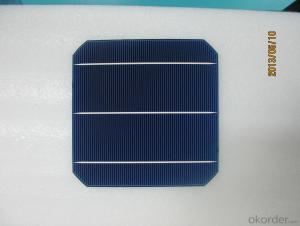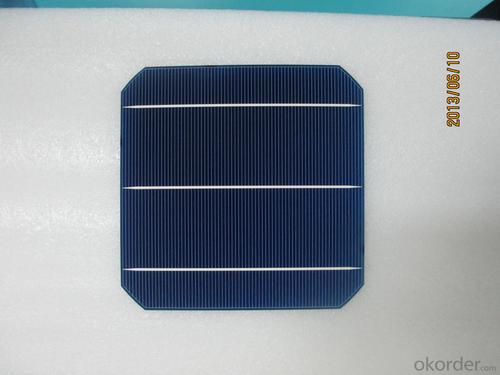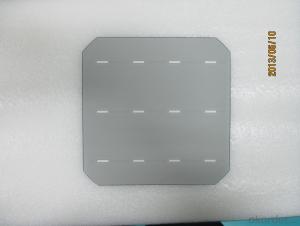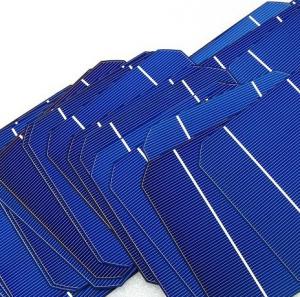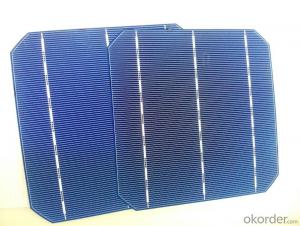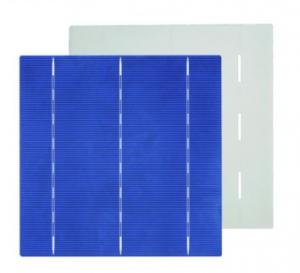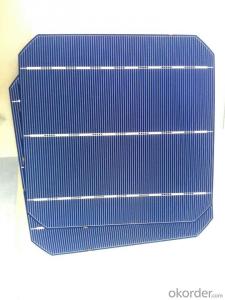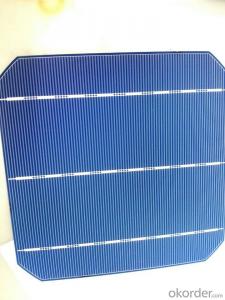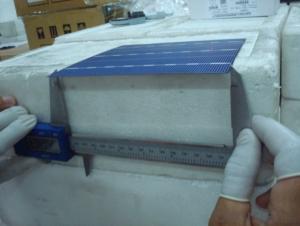Konarka Solar Cells - Monocrystal Solar Energy Cell 156*156mm with 18.6% Efficiency
- Loading Port:
- China Main Port
- Payment Terms:
- TT or LC
- Min Order Qty:
- -
- Supply Capability:
- 1000000 pc/month
OKorder Service Pledge
OKorder Financial Service
You Might Also Like
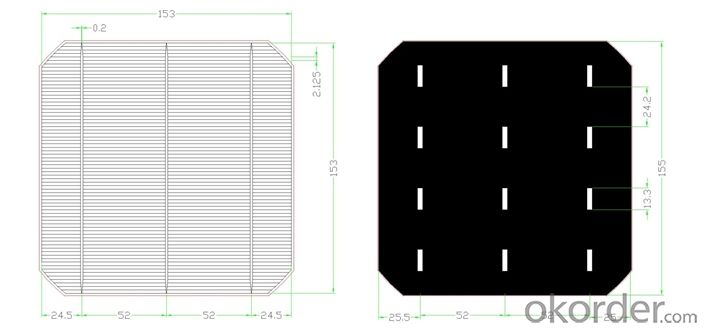
Monocrystal Solar Energy Cell
type:156M
appearance:156×1565㎜±0.5mm;diagonal:R=100mm
Main fence wide:1.4-1.5mm back electrode wide:2-2.5mm
Fence line qty:90
Cell thickness:220um±20um
Eff(%) | 18.00- 18.10 | 18.10- 18.20 | 18.20- 18.30 | 18.30- 18.40 | 18.40- 18.50 | 18.50- 18.60 | 18.60- 18.70 | 18.70- 18.80 | 18.80- 18.90 | 18.9- 19.0 | 19.1- 19.1 | 19.1- 19.2 |
Pm(W) | 4.30 | 4.33 | 4.35 | 4.37 | 4.40 | 4.42 | 4.44 | 4.47 | 4.49 | 4.52 | 4.54 | 4.56 |
Isc(A) | 8.71 | 8.73 | 8.76 | 8.77 | 8.78 | 8.82 | 8.83 | 8.85 | 8.86 | 8.88 | 8.9 | 8.93 |
Im(A) | 8.19 | 8.21 | 8.24 | 8.26 | 8.30 | 8.33 | 8.35 | 8.39 | 8.42 | 8.45 | 8.47 | 8.51 |
Voc(V) | 0.630 | 0.631 | 0.632 | 0.633 | 0.634 | 0.634 | 0.635 | 0.636 | 0.637 | 0.637 | 0.638 | 0.64 |
Vm(V) | 0.527 | 0.528 | 0.529 | 0.531 | 0.531 | 0.532 | 0.534 | 0.534 | 0.535 | 0.536 | 0.537 | 0.538 |
FF(%) | 78.6 | 78.7 | 78.8 | 79.0 | 79.2 | 79.3 | 79.5 | 79.6 | 79.8 | 80 | 80 | 80 |

remark:our company cells as per working current concentrate principle,separate the first and the second grade
Factory Picture of Solar Cells
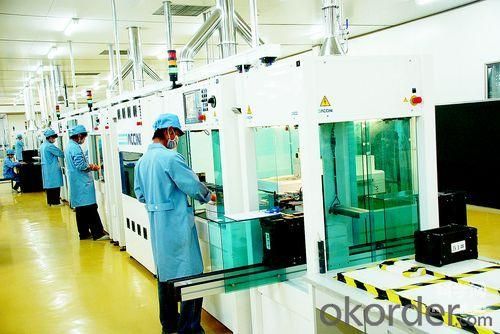
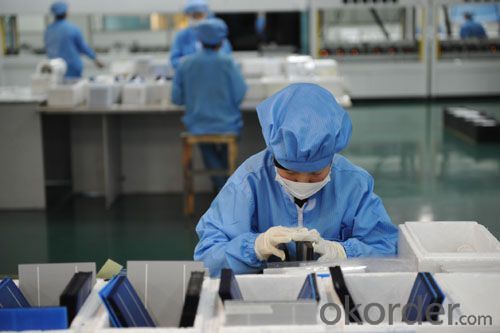
FAQ
We have organized several common questions for our clients,may help you sincerely:
What’s price per watt?
A: It’s depends on the quantity, delivery date and payment terms of the order. We can talk further about the detail price issue. Our products is high quality with lower price level.
Can you tell me the parameter of your solar cells?
We have different series of cells with different power output, both from c-si to a-si. Please take our specification sheet for your reference.
How do you pack your products?
We have rich experience on how to pack the panels to make sure the safety on shipment when it arrives at the destination.
Can you do OEM for us?
Yes, we can.
How long can we receive the product after purchase?
In the purchase of product within three working days, We will arrange the factory delivery as soon as possible. The perfect time of receiving is related to the state and position of customers. Commonly 7 to 10 working days can be served.
- Q: Can solar cells be used for powering universities?
- Yes, solar cells can be used to power universities. Solar energy is a renewable and sustainable source of power that can be harnessed through solar cells. By installing solar panels on university buildings and campuses, universities can generate clean electricity to meet their energy needs, reduce their carbon footprint, and potentially save costs on energy bills. Additionally, solar power systems can be integrated with battery storage technology to ensure a constant power supply, even during periods of low sunlight or at night.
- Q: What is the impact of solar cells on reducing noise pollution from power generation?
- Solar cells have a positive impact on reducing noise pollution from power generation as they operate silently, without the need for noisy machinery or moving parts.
- Q: Can solar cells be used to power communication systems?
- Yes, solar cells can be used to power communication systems. Solar cells convert sunlight into electricity, which can then be used to power various devices, including communication systems. This is particularly useful in remote or off-grid areas where traditional power sources are not readily available. Additionally, solar power is considered a clean and renewable energy source, making it an environmentally friendly choice for powering communication systems.
- Q: How do solar cells affect the electricity grid?
- Solar cells can have both positive and negative impacts on the electricity grid. On one hand, they can contribute to a more sustainable and renewable energy mix by generating clean electricity directly from sunlight. This reduces the need for fossil fuel-based power generation, leading to a decrease in greenhouse gas emissions and air pollution. Solar cells can also help diversify the energy sources in the grid, making it more resilient and less dependent on imported energy. On the other hand, the intermittent nature of solar power can pose challenges to the stability and reliability of the electricity grid. Since solar cells only generate electricity when the sun is shining, their output fluctuates throughout the day and is absent during nighttime. This can create imbalances between electricity supply and demand, as the grid needs to ensure a constant and reliable power supply to consumers. Additional measures, such as energy storage systems or backup power sources, may be required to address these intermittency issues and maintain grid stability. Overall, the integration of solar cells into the electricity grid presents opportunities for cleaner energy generation and reduced reliance on fossil fuels, but it also necessitates careful planning and the implementation of appropriate grid management strategies to mitigate potential challenges.
- Q: How much does a solar cell cost?
- Figuring out exactly the cost of the solar system you have can take a little detective work.
- Q: Can solar cells be used in wearable technology?
- Yes, solar cells can be used in wearable technology. They can be integrated into clothing, accessories, or even directly into the design of wearable devices to harness solar energy and power them. This allows for increased portability and sustainability as wearable technology can be charged on-the-go using solar power.
- Q: Can solar cells be used for powering remote sensing devices?
- Yes, solar cells can be used to power remote sensing devices. Solar cells convert sunlight into electricity, which can then be used to power various electronic devices, including remote sensing devices. This renewable energy source is particularly advantageous for remote sensing applications as it eliminates the need for traditional power sources and allows for greater flexibility and portability in remote locations.
- Q: Can solar cells be used to power agricultural irrigation systems?
- Yes, solar cells can indeed be used to power agricultural irrigation systems. Solar power provides a sustainable and reliable source of energy to pump water for irrigation, helping farmers reduce their dependence on fossil fuels and electricity grids. This approach is particularly beneficial in remote areas with limited access to conventional power sources.
- Q: Can solar cells be used for powering electric gates?
- Yes, solar cells can be used to power electric gates. Solar panels convert sunlight into electricity, which can be used to charge a battery or directly power the gate's motor. This allows the gate to operate without relying on the traditional power grid, making it more environmentally friendly and cost-effective in the long run.
- Q: How does solar cell technology apply to our daily life?
- Solar cells are used to make solar modules which generate electrical power from sunlight,
Send your message to us
Konarka Solar Cells - Monocrystal Solar Energy Cell 156*156mm with 18.6% Efficiency
- Loading Port:
- China Main Port
- Payment Terms:
- TT or LC
- Min Order Qty:
- -
- Supply Capability:
- 1000000 pc/month
OKorder Service Pledge
OKorder Financial Service
Similar products
Hot products
Hot Searches
Related keywords
